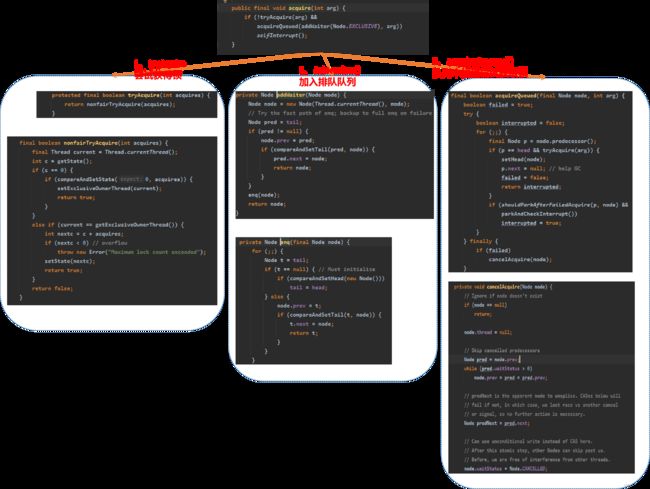一文让你彻底搞懂AQS(通俗易懂的AQS)
一文让你彻底搞懂AQS(通俗易懂的AQS)
一、什么是AQS
- AQS是一个用来构建锁和同步器的框架,使用AQS能简单且高效地构造出应用广泛的大量的同步器,比如我们提到的ReentrantLock,Semaphore,其他的诸如ReentrantReadWriteLock,SynchronousQueue,FutureTask等等皆是基于AQS的。当然,我们自己也能利用AQS非常轻松容易地构造出符合我们自己需求的同步器。
二、前置知识
- 学习AQS需要大家对同步锁有一定的概念。同时大家要知道LockSupport的使用,可以参考我这篇文章。(LockSupport从入门到深入理解)
三、AQS 的核心思想
- AQS核心思想是,如果被请求的共享资源空闲,则将当前请求资源的线程设置为有效的工作线程,并且将共享资源设置为锁定状态。如果被请求的共享资源被占用,那么就需要一套线程阻塞等待以及被唤醒时锁分配的机制,这个机制AQS是用CLH队列锁实现的,即将暂时获取不到锁的线程加入到队列中。 CLH(Craig,Landin,and Hagersten)队列是一个虚拟的双向队列(虚拟的双向队列即不存在队列实例,仅存在结点之间的关联关系)。AQS是将每条请求共享资源的线程封装成一个CLH锁队列的一个结点(Node)来实现锁的分配。 AQS使用一个int成员变量来表示同步状态,通过内置的FIFO队列来完成获取资源线程的排队工作。AQS使用CAS对该同步状态进行原子操作实现对其值的修改。 (图一为节点关系图)
private volatile int state;//共享变量,使用volatile修饰保证线程可见性
四、AQS 案例分析
上面讲述的原理还是太抽象了,那我我们上示例,结合案例来分析AQS 同步器的原理。以ReentrantLock使用方式为例。
代码如下:
public class AQSDemo {
private static int num;
public static void main(String[] args) {
ReentrantLock lock = new ReentrantLock();
new Thread(new Runnable() {
@Override
public void run() {
lock.lock();
try {
Thread.sleep(1000);
num += 1000;
System.out.println("A 线程执行了1秒,num = "+ num);
} catch (InterruptedException e) {
e.printStackTrace();
}
finally {
lock.unlock();
}
}
},"A").start();
new Thread(new Runnable() {
@Override
public void run() {
lock.lock();
try {
Thread.sleep(500);
num += 500;
System.out.println("B 线程执行了0.5秒,num = "+ num);
} catch (InterruptedException e) {
e.printStackTrace();
}
finally {
lock.unlock();
}
}
},"B").start();
new Thread(new Runnable() {
@Override
public void run() {
lock.lock();
try {
Thread.sleep(100);
num += 100;
System.out.println("C 线程执行了0.1秒,num = "+ num);
} catch (InterruptedException e) {
e.printStackTrace();
}
finally {
lock.unlock();
}
}
},"C").start();
}
}
执行的某一种结果! 这个代码超级简单,但是执行结果却是可能不一样,大家可以自行实验。



对比一下三种结果,大家会发现,无论什么样的结果,num最终的值总是1600,这说明我们加锁是成功的。
五、AQS 源码分析
- 使用方法很简单,线程操纵资源类就行。主要方法有两个lock() 和unlock().我们深入代码去理解。我在源码的基础上加注释,希望大家也跟着调试源码。其实非常简单。
5.1 AQS 的数据结构
AQS 主要有三大属性分别是 head ,tail, state,其中state 表示同步状态,head为等待队列的头结点,tail 指向队列的尾节点。
/**
* Head of the wait queue, lazily initialized. Except for
* initialization, it is modified only via method setHead. Note:
* If head exists, its waitStatus is guaranteed not to be
* CANCELLED.
*/
private transient volatile Node head;
/**
* Tail of the wait queue, lazily initialized. Modified only via
* method enq to add new wait node.
*/
private transient volatile Node tail;
/**
* The synchronization state.
*/
private volatile int state;
还需要再去了解 Node的数据结构,
在这里插入代码片
class Node{
//节点等待状态
volatile int waitStatus;
// 双向链表当前节点前节点
volatile Node prev;
// 下一个节点
volatile Node next;
// 当前节点存放的线程
volatile Thread thread;
// condition条件等待的下一个节点
Node nextWaiter;
}
waitStatus 只有特定的几个常量,相应的值解释如下:

本次源码讲解,我们一ReentranLock的非公平锁为例。我们主要关注的方法是lock(),和unlock()。
5.2 lock源码分析
首先我们看一下lock()方法源代码,直接进入非公平锁的lock方法:
final void lock() {
//1、判断当前state 状态, 没有锁则当前线程抢占锁
if (compareAndSetState(0, 1))
// 独占锁
setExclusiveOwnerThread(Thread.currentThread());
else
// 2、锁被人占了,尝试获取锁,关键方法了
acquire(1);
}
进入 AQS的acquire() 方法:
public final void acquire(int arg) {
if (!tryAcquire(arg) &&
acquireQueued(addWaiter(Node.EXCLUSIVE), arg))
selfInterrupt();
}
总-分-总
5.2.1 tryAquire 方法源码
- 既然是非公平锁,那么我们一进来就想着去抢锁,不管三七二一,直接试试能不能抢到,抢不到再进队列。
final boolean nonfairTryAcquire(int acquires) {
//1、获取当前线程
final Thread current = Thread.currentThread();
// 2、获取当前锁的状态,0 表示没有被线程占有,>0 表示锁被别的线程占有
int c = getState();
// 3、如果锁没有被线程占有
if (c == 0) {
// 3.1、 使用CAS去获取锁, 为什么用case呢,防止在获取c之后 c的状态被修改了,保证原子性
if (compareAndSetState(0, acquires)) {
// 3.2、设置独占锁
setExclusiveOwnerThread(current);
// 3.3、当前线程获取到锁后,直接发挥true
return true;
}
}
// 4、判断当前占有锁的线程是不是自己
else if (current == getExclusiveOwnerThread()) {
// 4.1 可重入锁,加+1
int nextc = c + acquires;
if (nextc < 0) // overflow
throw new Error("Maximum lock count exceeded");
// 4.2 设置锁的状态
setState(nextc);
return true;
}
return false;
}
5.2.2 addWaiter() 方法的解析
- private Node addWaiter(Node mode),当前线程没有货得锁的情况下,进入CLH队列。
private Node addWaiter(Node mode) {
// 1、初始化当前线程节点,虚拟节点
Node node = new Node(Thread.currentThread(), mode);
// Try the fast path of enq; backup to full enq on failure
// 2、获取尾节点,初始进入节点是null
Node pred = tail;
// 3、如果尾节点不为null,怎将当前线程节点放到队列尾部,并返回当前节点
if (pred != null) {
node.prev = pred;
if (compareAndSetTail(pred, node)) {
pred.next = node;
return node;
}
}
// 如果尾节点为null(其实是链表没有初始化),怎进入enq方法
enq(node);
return node;
}
// 这个方法可以认为是初始化链表
private Node enq(final Node node) {
// 1、入队 : 为什么要用循环呢?
for (;;) {
// 获取尾节点
Node t = tail;
// 2、尾节点为null
if (t == null) { // Must initialize
// 2.1 初始话头结点和尾节点
if (compareAndSetHead(new Node()))
tail = head;
}
// 3、将当前节点加入链表尾部
else {
node.prev = t;
if (compareAndSetTail(t, node)) {
t.next = node;
return t;
}
}
}
}
有人想明白为什么enq要用for(;;)吗? 咋一看最多只要循环2次啊! 答疑来了,这是对于单线程来说确实是这样的,但是对于多线程来说,有可能在第2部完成之后就被别的线程先执行入链表了,这时候第3步cas之后发现不成功了,怎么办?只能再一次循环去尝试加入链表,直到成功为止。
5.2.3 acquireQueued()方法详解
- addWaiter 方法我们已经将没有获取锁的线程放在了等待链表中,但是这些线程并没有处于等待状态。acquireQueued的作用就是将线程设置为等待状态。
final boolean acquireQueued(final Node node, int arg) {
// 失败标识
boolean failed = true;
try {
// 中断标识
boolean interrupted = false;
for (;;) {
// 获取当前节点的前一个节点
final Node p = node.predecessor();
// 1、如果前节点是头结点,那么去尝试获取锁
if (p == head && tryAcquire(arg)) {
// 重置头结点
setHead(node);
p.next = null; // help GC
// 获得锁
failed = false;
// 返回false,节点获得锁,,,然后现在只有自己一个线程了这个时候就会自己唤醒自己
// 使用的是acquire中的selfInterrupt();
return interrupted;
}
// 2、如果线程没有获得锁,且节点waitStatus=0,shouldParkAfterFailedAcquire并将节点的waitStatus赋值为-1
//parkAndCheckInterrupt将线程park,进入等待模式,
if (shouldParkAfterFailedAcquire(p, node) &&
parkAndCheckInterrupt())
interrupted = true;
}
} finally {
if (failed)
cancelAcquire(node);
}
}
private static boolean shouldParkAfterFailedAcquire(Node pred, Node node) {
int ws = pred.waitStatus;
if (ws == Node.SIGNAL)
/*
* This node has already set status asking a release
* to signal it, so it can safely park.
*/
return true;
if (ws > 0) {
/*
* Predecessor was cancelled. Skip over predecessors and
* indicate retry.
*/
do {
node.prev = pred = pred.prev;
} while (pred.waitStatus > 0);
pred.next = node;
} else {
/*
* waitStatus must be 0 or PROPAGATE. Indicate that we
* need a signal, but don't park yet. Caller will need to
* retry to make sure it cannot acquire before parking.
*/
compareAndSetWaitStatus(pred, ws, Node.SIGNAL);
}
return false;
}
- 好了,这个源码的解释就结束了,大家是不是还是云里雾里,不得不承认,这个代码太优雅了。不愧大神!
我用白话给大家串起来讲一下吧! 我们以reentrantLock的非公平锁结合我们案例4来讲解。
当线程A 到lock()方法时,通过compareAndSetState(0,1)获得锁,并且获得独占锁。当B,C线程去争抢锁时,运行到acquire(1),C线程运行tryAcquire(1),接着运行nonfairTryAcquire(1)方法,未获取锁,最后返回false,运行addWaiter(),运行enq(node),初始化head节点,同时C进入队列;再进入acquireQueued(node,1)方法,初始化waitStatus= -1,自旋并park()进入等待。
接着B线程开始去抢锁,B线程运行tryAcquire(1),运行nonfairTryAcquire(1)方法,未获得锁最后返回false,运行addWaiter(),直接添加到队尾,同时B进入队列;在进入acquireQueued(node,1)方法,初始化waitStatus= -1,自旋并park()进入等待。
5.3 unlock源码分析
unlock释放锁。主要利用的是LockSupport
public final boolean release(int arg) {
// 如果成功释放独占锁,
if (tryRelease(arg)) {
Node h = head;
// 如果头结点不为null,且后续有入队结点
if (h != null && h.waitStatus != 0)
//释放当前线程,并激活等待队里的第一个有效节点
unparkSuccessor(h);
return true;
}
return false;
}
// 如果释放锁着返回true,否者返回false
// 并且将sate 设置为0
protected final boolean tryRelease(int releases) {
int c = getState() - releases;
if (Thread.currentThread() != getExclusiveOwnerThread())
throw new IllegalMonitorStateException();
boolean free = false;
if (c == 0) {
free = true;
setExclusiveOwnerThread(null);
}
setState(c);
return free;
}
private void unparkSuccessor(Node node) {
/*
* If status is negative (i.e., possibly needing signal) try
* to clear in anticipation of signalling. It is OK if this
* fails or if status is changed by waiting thread.
*/
int ws = node.waitStatus;
if (ws < 0)
// 重置头结点的状态waitStatus
compareAndSetWaitStatus(node, ws, 0);
/*
* Thread to unpark is held in successor, which is normally
* just the next node. But if cancelled or apparently null,
* traverse backwards from tail to find the actual
* non-cancelled successor.
*/
// 获取头结点的下一个节点
Node s = node.next;
// s.waitStatus > 0 为取消状态 ,结点为空且被取消
if (s == null || s.waitStatus > 0) {
s = null;
// 获取队列里没有cancel的最前面的节点
for (Node t = tail; t != null && t != node; t = t.prev)
if (t.waitStatus <= 0)
s = t;
}
// 如果节点s不为null,则获得锁
if (s != null)
LockSupport.unpark(s.thread);
}
锁的释放这个还是很简单。
总结
这个源码的最好阅读方式是结合例子去自己一步步跟代码,把每一个步骤写在纸上,尝试一两遍你就会有非常清晰的认识。
大家多给些意见,写之前我信心满满觉得能写的让大家看懂,写完之后我觉得一坨屎。


